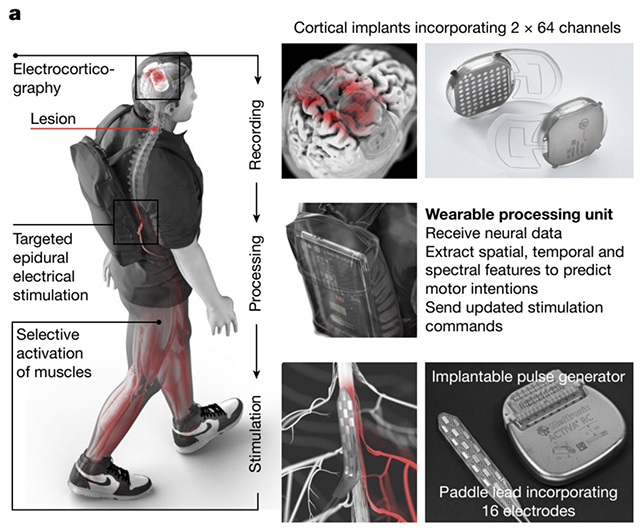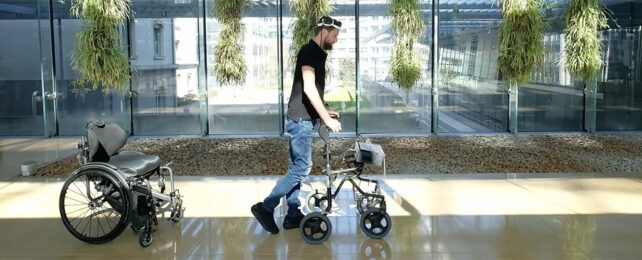A pair of implants forming a digital bridge between the brain and the spinal cord has enabled a 'test pilot' patient to better stand and walk again, showing promise for an innovation that could one day transform the lives of individuals with paralysis.
Led by researchers from the Swiss Federal Institute of Technology Lausanne (EPFL), the investigation involved a 40-year-old man named Gert-Jan, who had been paralyzed by a biking accident over a decade ago.
Gert-Jan had previously regained some ability to walk with the help of a front-wheel walker. For the three years before enrolling in the latest test though, he had reached a "neurological recovery plateau".
One of the implants tested on Gert-Jan sat above his brain, decoding electrical signals that initiated movement. It communicated with another implant connected to the part of the spinal cord responsible for triggering motion in his legs. Together, they're able to bypass the injured section of his cervical spinal cord, wirelessly reestablishing the link between his brain and body.
The implants seemed to not only restore some of the damaged connectivity in Gert-Jan's central nervous system the more they were used: after a year of working with the implants, and undergoing physical therapy, his walking ability had improved to the point he could walk with crutches even when the devices were turned off.
That's a good sign at least some of his neurons reorganized to restore communication, according to the researchers.
"We have created a wireless interface between the brain and the spinal cord using brain-computer interface (BCI) technology that transforms thought into action," says EPFL neuroscientist Grégoire Courtine.

Over the course of 12 months, the digital bridge implants were shown to help Gert-Jan walk and stand more naturally, without the extra wearable motion sensors used in previously tested technologies to detect and stimulate movement. In addition, the Brain-Spine Interface (BSI) introduced in this trial meant he could climb stairs and get across varying terrain (such as steep ramps, for example) – challenges that he couldn't manage before.
Key to the system are a series of artificial intelligence algorithms that are able to adapt and learn with user prompting. The patient has to train the model so it can decode which brain thoughts correspond to which movements, a process that takes a surprisingly short amount of time.
"The patient has first to learn how to work with his brain signals, and we also have to learn how to correlate these brain signals to the spinal cord stimulation," says Jocelyne Bloch, a neurosurgeon from EPFL. "This is pretty short: in a few sessions, everything is linked."
While this type of system won't work for every kind of spinal cord injury, and has only been tested on one person, there's huge potential here for using technology and AI to fill in the gaps in the nervous system caused by injury.
For Gert-Jan the progress has been slow at times, but his quality of life has been significantly improved by the implants, which he used at home. For instance, he can now stand at a bar to enjoy a beer with friends – something seemingly small that most of us take for granted, but which means a lot to Gert-Jan and his recovery.
"This simple pleasure represents a significant change in my life," he says.
The research has been published in Nature.
